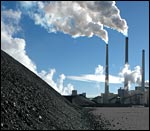
A story in a West Virginia newspaper slobbers over coal gasification — almost like the reporter got all her information from the industry. In West Virginia! Lawsy me. Needless to say, carbon dioxide isn’t even mentioned.
A more sober assessment can be found in several posts on Daily Kos (if you can survive all the blogofascism!). Responding to Montana Governor Brian Schweitzer’s NYT op-ed, Jerome a Paris asks him these questions. The Governor responded here. DarkSyde had this post about Schweitzer’s 60 Minutes appearance. And finally, in response to an NYT feature on synfuel, Schweitzer wrote this post.
Enough homework for you?
Schweitzer’s a smart, serious guy; of course it’s no secret that he’s advancing Montana’s interests, but he’s clearly no mere shill for the coal industry. And he’s explicit that gasification is not a long-term solution, but merely a bridge:
So coal-to-diesel, in my mind, is a piece of a larger national plan that 1) takes us through the next several decades to the hydrogen economy, 2) includes a heavy dose of biofuels and other renewables, 3) breaks oil dependence in the short term, and 4) provides a boost for technology that will help us combat global warming.
Having read a good bit about all this, my skepticism has not been overcome. Here are what I see as the big limitations on gasification/sequestration:
- Coal boosters say we have 250 years worth of coal in this country. But as Jeff Goodell argues persuasively in Big Coal, this number is wildly exaggerated. Much of that coal lies under inhabited or wilderness areas; the estimate is based on outdated studies; it assumes our usage won’t increase, but the whole point of "energy independence" would be to increase it substantially. In short, if we replace all oil with liquefied coal, we’d burn through the coal quickly and do immeasurable damage to our natural landscapes in the process.
- Schweitzer brushes off concern about mining, saying the surface mining in Montana is safe and landscapes are reclaimed. The truth is a bit more complicated.
- Right now, the only demand for CO2 sequestration comes from enhanced oil recovery. Do we really want to enable the recovery of tons more oil, which would bring the price of oil down and, oh yeah, get burned and release CO2?
- Who’s going to pay for all the sequestration that doesn’t help recover oil? Remember, if coal-to-liquid is to replace any substantial percentage of our oil, there’s going to have to be a lot of it, and that means a lot of sequestration. Sequestration requires a great deal of money and a particular set of geological features. How will it scale up?
One could go on. Weighing against these negatives is one overwhelming consideration:
- The hard, unavoidable fact that dozens, probably hundreds, of coal plants are going to be built around the world soon. If they are IGCC plants, we at least have a hope of sequestering the CO2. If they are conventional coal-fired power plants, all other efforts to slow the release of GHGs will be overwhelmed. Game over. Preventing the construction of these conventional coal plants should be our absolute first priority in the global warming fight. All else depends on it.
So there you have it. (See also Goodell’s op-ed about gasification in the NYT, and watch for my interview with him this coming week.)
Thoughts?


